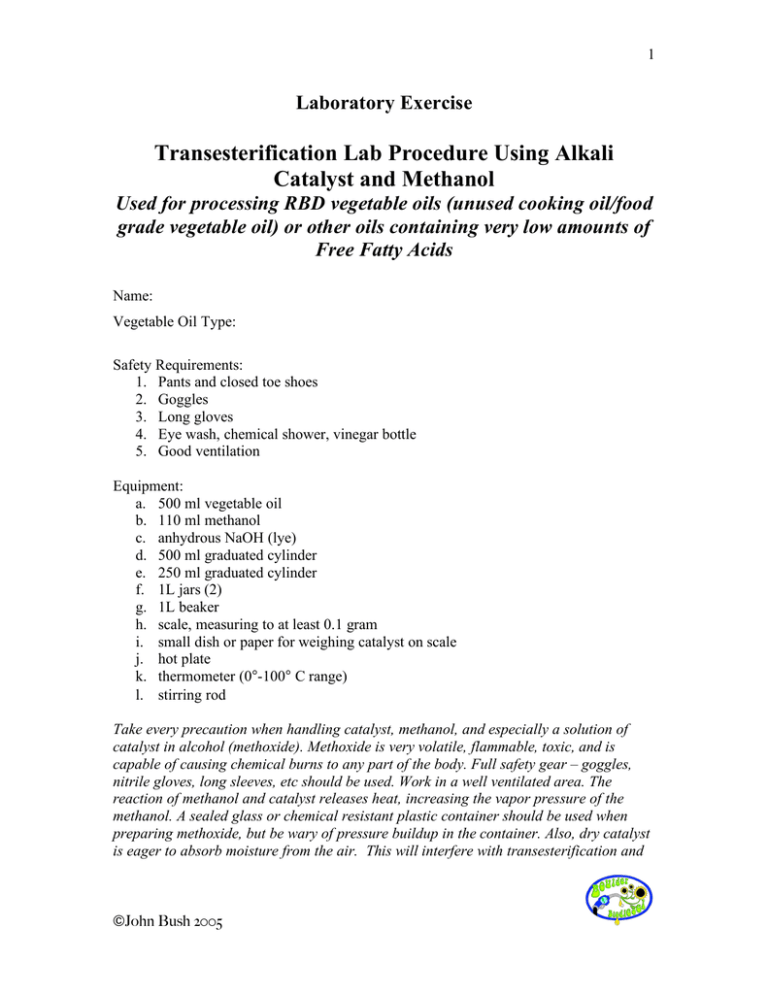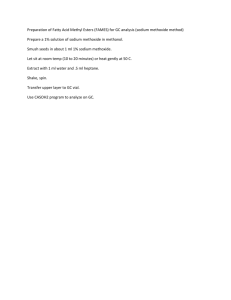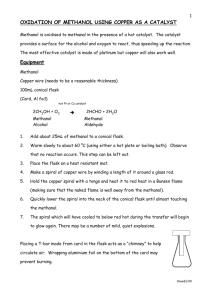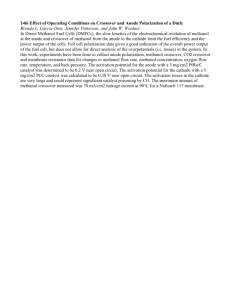Transesterification Lab Procedure: Alkali Catalyst & Methanol
advertisement

1 Laboratory Exercise Transesterification Lab Procedure Using Alkali Catalyst and Methanol Used for processing RBD vegetable oils (unused cooking oil/food grade vegetable oil) or other oils containing very low amounts of Free Fatty Acids Name: Vegetable Oil Type: Safety Requirements: 1. Pants and closed toe shoes 2. Goggles 3. Long gloves 4. Eye wash, chemical shower, vinegar bottle 5. Good ventilation Equipment: a. 500 ml vegetable oil b. 110 ml methanol c. anhydrous NaOH (lye) d. 500 ml graduated cylinder e. 250 ml graduated cylinder f. 1L jars (2) g. 1L beaker h. scale, measuring to at least 0.1 gram i. small dish or paper for weighing catalyst on scale j. hot plate k. thermometer (0°-100° C range) l. stirring rod Take every precaution when handling catalyst, methanol, and especially a solution of catalyst in alcohol (methoxide). Methoxide is very volatile, flammable, toxic, and is capable of causing chemical burns to any part of the body. Full safety gear – goggles, nitrile gloves, long sleeves, etc should be used. Work in a well ventilated area. The reaction of methanol and catalyst releases heat, increasing the vapor pressure of the methanol. A sealed glass or chemical resistant plastic container should be used when preparing methoxide, but be wary of pressure buildup in the container. Also, dry catalyst is eager to absorb moisture from the air. This will interfere with transesterification and ©John Bush 2005 2 should be avoided. Always keep containers holding lye and methanol tightly closed when not in use. Step 1: Preparing the Methoxide Solution 1. Measure 110 ml methanol and place into 1L jar. Cap the jar with the lid and tighten securely. 2. Measure 2 grams NaOH and quickly add it into the methanol, minimizing its exposure to air. Recap the jar with the lid and tighten securely. Label the jar “Danger: Methoxide” along with the amount of methanol and NaOH. 3. With enough time, the catalyst will dissolve in the methanol, though gentle agitation helps. Make sure all of the solid catalyst has dissolved in the methanol before proceeding. Be careful, the methoxide solution just created is the most dangerous substance used in biodiesel production. Step 2: Transesterification 1. Measure 500 ml of oil and place in 1L beaker. 2. Using hot plate, heat the oil to 55°C but not more! Methanol boils at about 64°C at sea level, lower at higher elevations. 3. Place oil into 1L jar labeled with the type and quantity of feedstock, catalyst, and methanol used. Quickly but carefully add the methoxide solution to the jar of oil. Use caution when re-opening the jar of methoxide. Any pressure buildup from the methanol/catalyst reaction should be released slowly. Ensure that the lid is securely fastened. Clean the lid and jar of any spilled methanol or oil. 4. Shake jar vigorously for at least 10 minutes Use caution, don’t drop the jar! 5. Set jar in a warm place and leave to allow settling. Notes & Questions: ©John Bush 2005





